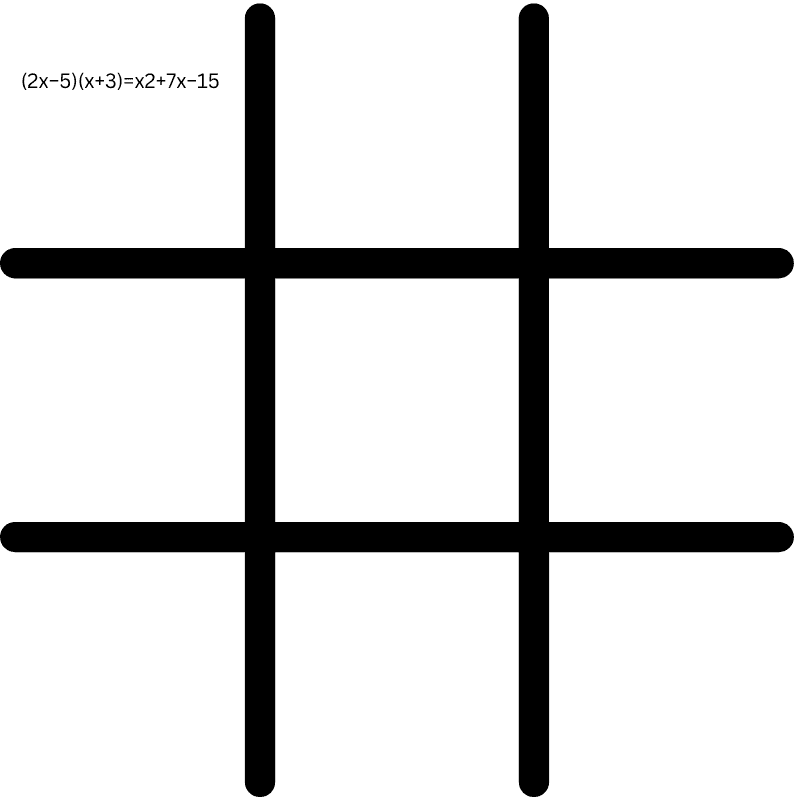Math in high school matters. You have GPAs, AP/IB, SAT/ACT, college readiness, and a whole lot more. But that doesn't mean it has to be dry or painful. You can make math fun to learn by turning practice into games, projects, and puzzles your students actually want to try.
Below are 13 math club and classroom-friendly activities tailored for high school learners, emphasizing algebra, geometry, trigonometry, statistics, and more. Some are upgrades of familiar ideas, while others push into new territory.
| Activity | Description | Skills Practiced |
|---|---|---|
| Quadratic & Trig Tic-Tac-Toe | Fill Tic-Tac-Toe squares with problems (quadratics, logs, trig identities). Students solve to claim spaces. | Algebra, trigonometry, strategy, critical thinking |
| Exponent & Log Battle | Roll dice or draw cards to build exponent/log expressions. Players evaluate, simplify, or convert to log form. | Exponents, logarithms, algebra fluency |
| Calculus Dice Challenge | Roll dice to form functions (e.g., 2x³, sin(3x)). Students race to find derivatives or integrals. | Differentiation, integration, algebraic manipulation |
| Math Jeopardy | Play a Jeopardy-style review game with categories like trig, limits, exponents/logs, and probability. | Concept review, problem-solving, teamwork |
| Graphic Scavenger Hunt | Follow a series of graphing clues (points, slopes, intersections) hidden around the classroom. | Graphing, coordinate geometry, systems of equations |
| Transversal Geometry Relay | Students act out angle positions with tape lines, then race to prove relationships like alternate interiors. | Geometry proofs, angle relationships, teamwork |
| Rational Expressions War | Use custom polynomial cards to build rational expressions. First to simplify and state restrictions wins. | Factoring, simplification, domain restrictions |
| Pi Day Challenges | Celebrate 3/14 with advanced tasks: radian conversion, arc length, series approximations for π. | Geometry, radians, series, math applications |
| Advanced KenKen | Solve larger 5×5 or 6×6 KenKen puzzles with operations beyond addition and subtraction. | Logic, arithmetic fluency, algebraic reasoning |
| Search & Rescue (Statistics) | Simulate locating a lost ship by updating probabilities as new clues arrive. | Conditional probability, Bayesian reasoning, data analysis |
| Math Research Projects | Students explore topics that connect math with real-world interests (e.g., cryptography, sports, art). | Research, applied math, communication |
| NRICH Interactive Games | Play strategic math puzzles from the NRICH library to challenge number sense and reasoning. | Number theory, combinatorics, strategic thinking |
| Maze Problem Game | Solve a sequence of math problems where each correct answer reveals the next step. | Algebra, persistence, sequential reasoning |
1. Quadratic & Trig Tic-Tac-Toe
Use a regular Tic-Tac-Toe grid, but each square holds a high school–level problem (e.g. solve a quadratic, simplify ln(x), evaluate a sine/cosine identity). A student answers correctly to place X or O. This turns a classic into strategic practice of algebra and trig. Resource: Teach-nology Tic-Tac-Toe templates

2. Exponent & Log Battle
Students roll dice (or draw cards) to build expressions. For example: Roll a 3 and a 4 → expression is “3 raised to the 4th power” (answer: 81). Or: Flip a card that says “2 to what power equals 16?” → answer: 4.
Players race to evaluate, simplify, or rewrite the expression in log form (like log base 2 of 16 equals 4). Bonus rounds can use bigger bases or trickier questions. This builds fluency with exponent rules and their connection to logarithms, a core skill for Algebra II and Precalculus.
Resource: Exponent practice game
3. Calculus Dice Challenge
Give each die a role: one for coefficients, one for powers, and one for functions (like sine, cosine, or exponential). Roll them together to build a problem such as “2x³” or “sin(3x).” Students then race to take the derivative, find the integral, or simplify the result.
Example: Roll a 2, an x³, and “differentiate.” The task is to take the derivative of 2x³ → answer: 6x².
This fast-paced game turns random dice rolls into quick-fire practice with derivatives and integrals, keeping energy high while reinforcing calculus fluency.
4. Math Jeopardy: High School Edition
Run a Jeopardy-style review with categories like Trig Identities, Limits & Derivatives, Exponent / Log Rules, Probability & Statistics, Algebra II Problem Solving. Keeps energy high while reinforcing the core content teens will be tested on.
5. Graphic Scavenger Hunt
Place clues around the classroom or outdoors: each clue reveals a plotted point, slope, distance, or intersection. Students move to each location in turn, solving the mini-problem to get the next clue. For advanced variation: include conic sections or piecewise graphs.
For example:
Clue 1: “Plot the point (2, 3). The next clue is 5 units away on the line with slope –1.” Students must figure out that means the next location is at (–3, 8).
Clue 2: “Find the midpoint between (–3, 8) and (1, 0). That’s where your next clue is posted.”
Clue 3: “Solve the system: y = x² and y = 2x + 3. The intersection point is where you’ll find the final envelope.”
Students work in teams to solve each step. The hunt ends when they find the last clue or “treasure.”
6. Transversal Geometry Relay + Proof
Turn geometry proofs into a movement game. Use tape or ropes on the floor to mark two parallel lines with a transversal cutting across. Students stand at the intersections to “become” the angles. When the teacher calls out pairs—like alternate interior or corresponding angles—teams race to identify them and then write a quick proof showing why they’re congruent.
This keeps geometry interactive while reinforcing angle relationships and proof skills.
7. Rational Expressions War
Use custom cards printed with polynomials (numerator/denominator). Flip two to create a rational expression. Players race to factor, simplify, and state domain restrictions. No standard 52-card deck works here —the math drives the gameplay.
8. Pi Day Challenges
Celebrate 3/14 with deeper tasks:
- Convert between degrees and radians
- Compute arc lengths and sector areas
- Use series approximations or continued fractions for ????
This keeps it festive but mathematically rigorous.
Resource: Pi Day Activities for High School Students
9. Advanced KenKen / Caged Puzzles
Use larger KenKen grids (5×5 or 6×6) with operations including multiplication, division, and exponents. KenKen fosters logic, arithmetic fluency, and algebraic thinking. (KenKen’s educational benefits are well-documented.)
10. Search & Rescue (Bayesian / Statistics)
Model a “lost ship at sea” scenario: start with a probabilistic region, then update probabilities as “clues” arrive (e.g. drift, last known spot).
Teens get hands-on with Bayesian updating, conditional probability, and data interpretation.
For example:
Imagine the Coast Guard is searching for a missing boat. At first, the boat could be in three equal zones (A, B, C), so each has a 1/3 chance.
Clue 1: A radio signal is faintest near Zone C. Students update the probabilities: A = 0.25, B = 0.25, C = 0.50.
Clue 2: A debris field is spotted near Zone B. Students adjust again: A = 0.15, B = 0.60, C = 0.25.
Clue 3: Drift models show currents would have pushed the boat northeast, matching Zone B. Final update: B = 0.80, A = 0.10, C = 0.10.
The team concludes Zone B is most likely.
This way, students practice conditional probability and Bayesian thinking while solving a realistic, story-driven problem
Resource: Science Journal for Kids: Lost at Sea
11. Math Research / Passion Projects
Let students pick a topic that bridges math and their interests:
- Cryptography & prime factorization
- Election systems and voting theory
- Knot theory or graph theory
- Bayesian models in sports (predicting wins)
- Algorithmic models in social media or networks
- Optimisation in logistics or economics
- Mathematics of music, architecture, or visual arts
12. Interactive Math Games from NRICH
NRICH offers a library of interactive, strategic games for secondary students that probe number theory, combinatorics, geometry, and puzzles.
nrich.maths.org. You can use these directly or adapt them for classroom play as warmups or extension.
13. Maze / Chain Problem Game
Write a series of problems where each answer leads to the next problem (like a treasure map). Students solve in sequence; if incorrect, they can’t move forward. TeachForAmerica describes this as a “maze game” style for math review.
Have Fun with Math Today!
Looking for a little extra help? iD Tech offers live online math tutoring to help your student succeed and thrive in the classroom.
Options include:
